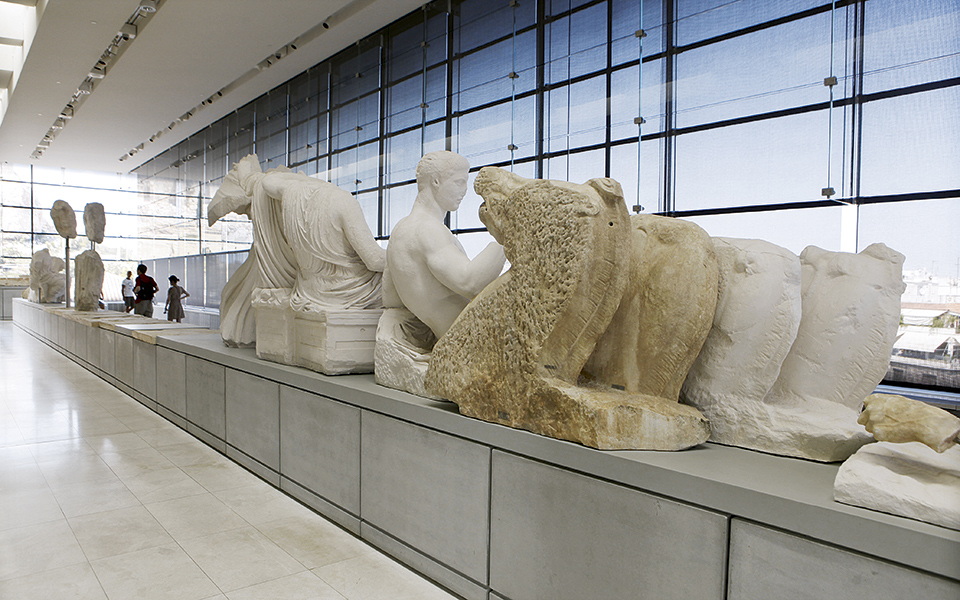By George Vardas
On June 20, Greece and the world museum community celebrated the 10th anniversary of the inauguration of the Acropolis Museum in Athens. The state-of-the-art museum is rightly regarded as a defining structure that has established a dialogue, across time and space, between the sculptural works it houses and the Sacred Rock itself.
But amidst all the euphoria, we should not forget the main reason why the museum was built – namely, to counter the British argument that the Greeks did not have a suitable museum for the Parthenon Sculptures even if they were ever returned to Athens.
For years the British Museum had dreaded the moment when a new museum would rise from the ground in Athens.
In fact, on March 22, 1991, the former keeper of Greek and Roman antiquities at the museum, Brian Cook, had sent a memo to the BM director with this warning: “The next phase of the campaign for repatriation is likely to begin any time after the actual start of construction of the new Acropolis Museum. The problem has not gone away, it is merely in hibernation; and when it wakes up, our successors will find that it is fiercer than before.”
The Greeks had also assumed the new museum would complete the case for return. As a 2002 report in the Washington Post noted, Greece was building the museum in hope of reinforcing efforts to change the negative stance of the British government and “shaming the British government into giving back sculptures taken two centuries ago.”
Prior to the actual unveiling of the museum in 2009, then Prime Minister Costas Karamanlis declared: “Once the museum is completed, Greece will have a very strong argument for the return of the Parthenon Sculptures. We are taking a very important step to finally realize a dream that unites all Greeks.”
The Acropolis Museum has therefore always been the centerpiece of the campaign for the return of the Parthenon Sculptures, but unfortunately it was assumed that, once built, the case for return would be beyond question.
For a start, the British Museum had other ideas. Over the last decade it has carefully rebranded itself as the universal museum, the “museum of the Enlightenment,” the “collective memory of mankind,” a museum at the “center of a conversation with the world,” and therefore the logical repository for the marbles. Today, it arrogantly describes itself as the “museum of and for the world.”
According to the British Museum, the life of the Elgin Marbles as part of the story of the Parthenon is over and they are now part of another narrative, that of the British Museum in London, in a not too subtle attempt to suppress the context of their origin.
In April 2018, for example, the British Museum hauled some 12 pedimental sculptures, metopes and parts of the frieze into a separate hall in the museum under the pretext of displaying these works of art together with sculptures by the renowned French sculptor Auguste Rodin.
In its press release the British Museum stressed that the exhibition “will provide a new opportunity to focus on the Parthenon Sculptures as individual works rather than as part of an ensemble” as an obvious counter to the claim that the sculptures are integral to a unique monument.
While Greece may have a new museum in Athens, the BM has devised a new political and diplomatic playbook by which it promotes the sculptures as individual works of art which can be dispersed or dismembered as the trustees see fit, with no intention of ever returning the collection to Athens.
Meanwhile, cultural diplomacy via mediation through UNESCO has been rejected. Resolutions made at the UNESCO Intergovernmental Committee for Promoting the Return of Cultural Property over the last 30 years for meaningful negotiations to be conducted between Greece and Great Britain have also been routinely ignored by the British side.
So, while we can justifiably celebrate the 10th anniversary of the Acropolis Museum as a magnificent museum and the unifying element for the Parthenon and its sculptures, the unfortunate reality is that we are really no closer to the marbles’ return.
The next Greek government needs to carefully reassess its approach and to embrace all available political, diplomatic and legal options to bring about an effective resolution so that one day, when all the known surviving sculptures are finally reunited from the British Museum and elsewhere, the Parthenon Gallery on the top floor of the Acropolis Museum can truly be regarded as the most famous single room of Classical Greek art in the world. Only then will the Greek Stones truly speak.
* George Vardas is vice chair of Australians for the Return of the Parthenon Sculptures.
This article was originally published on ekathimerini.com.











